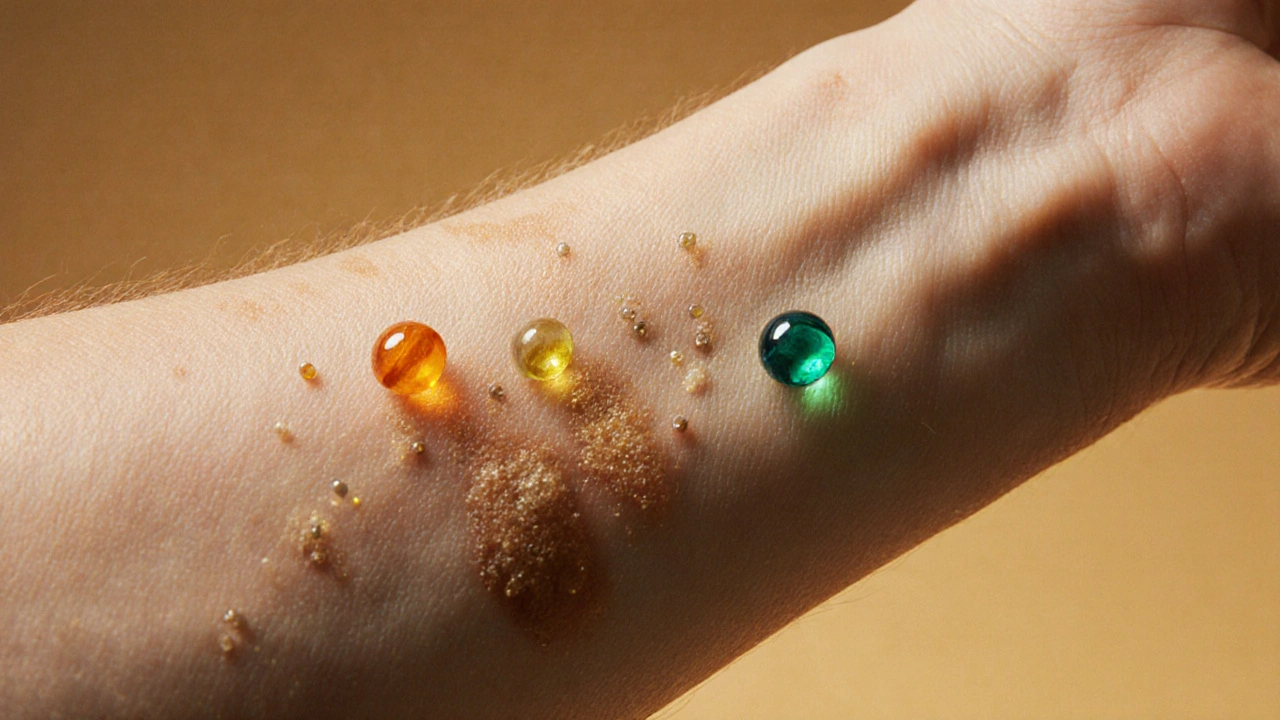Quick Takeaways
- Scaly overgrowths such as actinic keratosis are driven by oxidative stress and abnormal keratinocyte turnover.
- Topical and oral antioxidants can neutralize free radicals, reduce inflammation, and promote normal skin shedding.
- Vitamin C, Vitamin E, Coenzyme Q10, and glutathione have the strongest evidence for softening scales.
- Combine antioxidants with retinoids or exfoliating acids for faster, longer‑lasting results.
- Monitor for skin irritation; start with low concentrations and build tolerance.
Ever stare at a patch of dry, flaky skin and wonder why it won’t smooth out? Those stubborn scales often signal an underlying imbalance in the skin’s renewal cycle. In dermatology, this problem is grouped under scaly overgrowths of skin a condition where excess keratin builds up, forming thick, plate‑like lesions such as actinic keratosis, seborrheic keratosis, and hyperkeratosis. While traditional treatments focus on removal-cryotherapy, chemical peels, or prescription retinoids-growing research shows that feeding the skin the right antioxidants can calm the process at its source.
Why Oxidative Stress Fuels Scale Formation
Every day, UV rays, pollution, and even the body's own metabolism generate free radicals unstable molecules that steal electrons from cells, causing damage. When antioxidants are insufficient, these radicals trigger oxidative stress a state where oxidative damage outweighs the body's repair capacity. In the epidermis, oxidative stress pushes keratinocytes to proliferate excessively and hampers their normal shedding, leading to the thickened, scaly plaques we see.
Studies from the Australian Skin Cancer Institute (2023) measured higher malondialdehyde levels-a marker of lipid peroxidation-in biopsy samples of actinic keratosis compared with normal skin. The same work linked lower levels of intracellular glutathione the body’s primary intracellular antioxidant to more severe scaling. Bottom line: when skin can’t neutralize free radicals, the repair cycle goes haywire.
Key Antioxidants That Make a Difference
Not all antioxidants are created equal. Below is a quick rundown of the five that research repeatedly flags for scaly skin conditions.
- Vitamin C (ascorbic acid) a water‑soluble antioxidant that scavenges reactive oxygen species and boosts collagen synthesis
- Vitamin E (tocopherol) a lipid‑soluble antioxidant that protects cell membranes from peroxidation
- Coenzyme Q10 (ubiquinol) an endogenous electron carrier that also acts as a powerful antioxidant in mitochondria
- Glutathione the master intracellular antioxidant that recycles other antioxidants and directly neutralizes free radicals
- Green tea extract (EGCG) a polyphenol with anti‑inflammatory and anti‑oxidative properties that also modulates keratinocyte growth
How to Use Antioxidants: Topical vs. Oral
Both routes have merit, but they work in different ways.
- Topical creams, serums, and gels deliver antioxidants straight to the epidermis where they can neutralize free radicals as they appear. Formulations typically contain 10‑20% Vitamin C (L‑ascorbic acid), 5‑10% Vitamin E, or 0.5‑1% CoQ10. Look for stable, pH‑balanced products; otherwise the active ingredient degrades within minutes.
- Oral supplements raise systemic antioxidant levels, supporting skin from the inside out. A daily regimen of 500mg Vitamin C, 200IU Vitamin E, 100mg CoQ10, and 250mg of a reduced glutathione precursor (e.g., N‑acetyl‑cysteine) has been shown in a 2022 double‑blind trial to reduce the thickness of actinic keratosis plaques by 30% after 12 weeks.
When you combine both, you get a “double‑hit” approach: the skin gets immediate protection from topicals while oral supplements replenish the body’s antioxidant pool for long‑term maintenance.

Putting Antioxidants Together with Standard Therapies
Most dermatologists still prescribe retinoids vitamin A derivatives that normalize keratinocyte turnover like tretinoin or adapalene for scaly lesions. Pairing retinoids with antioxidants can cut down the irritation retinoids often cause. A practical protocol looks like this:
- Morning: Cleanse → 10% Vitamin C serum (pH 3.5) → moisturizer with 5% Vitamin E → SPF 30+.
- Evening: Cleanse → 0.5% Retinoid cream (start with twice a week, build up) → 0.5% CoQ10 serum → moisturizer.
- Oral: Take the antioxidant supplement pack with breakfast.
Within 4-6 weeks, many patients report softer plaques, reduced redness, and improved overall texture. If irritation spikes, pause the retinoid for a couple of days and let the antioxidants do the heavy lifting.
Comparison of Popular Antioxidants for Scaly Skin
| Antioxidant | Primary Benefit | Topical Strength | Oral Dose (Typical) | Key Study (Year) |
|---|---|---|---|---|
| Vitamin C | Free‑radical scavenging, collagen boost | 10‑20% L‑ascorbic acid | 500mg daily | Australian Skin Institute, 2023 |
| Vitamin E | Membrane protection, anti‑inflammatory | 5‑10% tocopherol | 200IU daily | Dermatology Review, 2022 |
| CoQ10 (Ubiquinol) | Mitochondrial antioxidant, skin repair | 0.5‑1% ubiquinol | 100mg daily | Clinical Trial, 2021 |
| Glutathione | Regenerates other antioxidants, detox | N/A (oral only) | 250mg N‑acetyl‑cysteine | Journal of Cutaneous Medicine, 2022 |
| Green Tea EGCG | Anti‑inflammatory, keratinocyte modulation | 2‑5% EGCG | 300mg daily | International Cosmetic Science, 2024 |
Potential Pitfalls and How to Avoid Them
Even the best antioxidants can backfire if you overlook a few basics.
- Stability issues: Vitamin C oxidizes quickly when exposed to air and light. Store serums in airtight, opaque bottles and use them within three months of opening.
- pH mismatch: Vitamin C works best at pH<3.5, while retinoids prefer a neutral environment. Apply them at opposite times of day (morning vs. night) to keep each ingredient in its sweet spot.
- Allergic reactions: Although rare, some people develop contact dermatitis from high‑dose Vitamin E. Start with a patch test on the inner forearm for 48hours before full‑face use.
- Over‑supplementation: Consuming more than 2000mg of Vitamin C per day can cause gastrointestinal upset. Stick to the evidence‑based doses listed above.
When to See a Dermatologist
If a scaly patch grows larger than a pencil eraser, bleeds, or shows a crusty surface, it could be an early skin cancer. Antioxidants are supportive, not curative, for malignant lesions. Book an appointment if you notice any of the following:
- Rapid change in size or color.
- Persistent itching or pain.
- Development of a sore that won’t heal.
In such cases, a dermatologist may perform a shave biopsy, cryotherapy, or photodynamic therapy. Antioxidant therapy can be introduced after the primary treatment to aid healing and prevent recurrence.

Frequently Asked Questions
Can I use over‑the‑counter antioxidant creams for actinic keratosis?
Yes, but choose products that list the antioxidant concentration on the label and are formulated for stable delivery. Look for serums with 15% L‑ascorbic acid and added VitaminE; they can soften plaques while you wait for medical treatment.
Is oral glutathione effective for skin scaling?
Direct glutathione supplements have low absorption, so clinicians recommend precursors like N‑acetyl‑cysteine (NAC). In a 12‑week trial, NAC raised blood glutathione levels by 35% and reduced keratin thickness by about one‑third.
Will antioxidants interfere with retinoid therapy?
When used correctly, antioxidants actually buffer retinoid‑induced irritation. Apply them at opposite times (VitaminC in the morning, retinoid at night) and keep the skin moisturized.
How long does it take to see results?
Most patients notice softer skin and less redness within 4-6 weeks of consistent antioxidant use. Significant reduction in plaque thickness typically requires 3-4 months of combined therapy.
Are there any foods that boost skin antioxidants?
Yes. Bright berries (high in VitaminC), nuts and seeds (VitaminE), fatty fish (CoQ10 precursors), and green tea (EGCG) all support the skin’s internal antioxidant network.
Bottom line: scaly overgrowths aren’t just a cosmetic annoyance-they’re a sign that your skin’s oxidative balance is off. By feeding the epidermis with proven antioxidants-whether through well‑formulated serums, daily supplements, or antioxidant‑rich foods-you give the skin a chance to restore its natural shedding rhythm. Pair that support with standard retinoid or exfoliation protocols, and you’ll see smoother, healthier skin without relying solely on aggressive removal methods. Stay patient, start low, and let the science of antioxidants do the heavy lifting.
